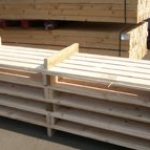We may receive a commission when you use our affiliate links. However, this does not impact our recommendations.
 Popular Woodworking Magazine has had a Byrd cutterhead in our 20” planer since late 2010. (Click here to watch an installation video.) Up until now, we have had no problems, but while milling stock for an upcoming project, I noticed significant planer tracks coming from the right-hand side of the planer. There were nicks with which to contend.
Popular Woodworking Magazine has had a Byrd cutterhead in our 20” planer since late 2010. (Click here to watch an installation video.) Up until now, we have had no problems, but while milling stock for an upcoming project, I noticed significant planer tracks coming from the right-hand side of the planer. There were nicks with which to contend.
With a three-knife head, this could mean you need to resharpen and replace all the knives. At minimum you would need to shift the knives so the nicks were not aligned. Either way you are going to have to dig out a dial indicator and get to work. With a Byrd head or other spiral cutterhead, the fix is super easy. No dial caliper necessary.
 If you notice tracks in your stock, you need to locate the individual knives affected. The best way to do this is with a visual inspection however, wood junk on the knives can look like small nicks. After a quick dusting with a small brush to reduce the potential number of nicked knives, I tested candidates with a thumbnail. Nicks stand out when using this test method.
If you notice tracks in your stock, you need to locate the individual knives affected. The best way to do this is with a visual inspection however, wood junk on the knives can look like small nicks. After a quick dusting with a small brush to reduce the potential number of nicked knives, I tested candidates with a thumbnail. Nicks stand out when using this test method.
 I grabbed a star wrench and pulled a bad knife from the journal. Before you rotate and replace the knife, you need to make sure any and all dust and junk is off the head so you do not trap things between the individual knives and the journal. I brushed away all I could then used a small piece of #400-grit silicon-carbide sandpaper to lightly clean the area. I also cleaned the back of the knife using the same sandpaper. I couple quick buffs on a dead-flat surface worked great.
I grabbed a star wrench and pulled a bad knife from the journal. Before you rotate and replace the knife, you need to make sure any and all dust and junk is off the head so you do not trap things between the individual knives and the journal. I brushed away all I could then used a small piece of #400-grit silicon-carbide sandpaper to lightly clean the area. I also cleaned the back of the knife using the same sandpaper. I couple quick buffs on a dead-flat surface worked great.
With each area clean and ready, I reinstalled the knife and set the screw with hand pressure. After rotating fives knives, I set the hood and dust shoot in place and took the head for a test drive. No planer tracks could be seen – we’re back in operation. I sure don’t miss setting planers knives. Maybe we should sell our dial indicator on Ebay.

A before and after photo of the knife back clearly shows why you need to clean the backs. Wood dust can affect cut quality, but a blob of wood residue such as that found here can wreak havoc.
Need more help with or information about planers? Check out these:
- If you need to change your three-knife cutterhead, order “Setting Jointer & Planer Knives.”
- Proper lumber preparation is paramount to smooth running builds. Pick up “The Right Way to Prepare Lumber.”
- If you’re interested in using a planer to taper legs, you need “Four Ways to Make Tapered Legs.”
Here are some supplies and tools we find essential in our everyday work around the shop. We may receive a commission from sales referred by our links; however, we have carefully selected these products for their usefulness and quality.











I disagree with rotating only nicked cutters. A reinterpretation of shifting a straight knife blade should be utilized when addressing nicks in carbide cutters. Carbide cutters are either numbered or there is a tick mark in one corner. At all times all cutters should be cutting on the same cutting edge whether by number or orientation of the tick mark. If a nick develops and a line appears in a planed board, there is a nick in all four or six carbide cutters around that cutterhead. Just like with a straight knife planer when you offset one knife; with carbide cutters you remove one of the nicked cutters and switch it with another cutter from anywhere else on the cutterhead. I call it hop-scotching cutters. This way you keep all cutting edges the same and you still have an equal number of sharp and dull cutting edges on your cutters. Add to that, if you plane wood prone to silica deposits or just grit such as in reclaimed wood, the carbide cutters wear down ever so slightly all the way around the cutterhead. This wear causes the cutting edge to recede. So when all of your cutters recede back, then you get a nick, then you rotate the culprits, that new cutting edge stands proud by however many thousandths-of-an-inch cutting deeper into your board leaving a bigger track. So I advise don’t rotate, hop-scotch.